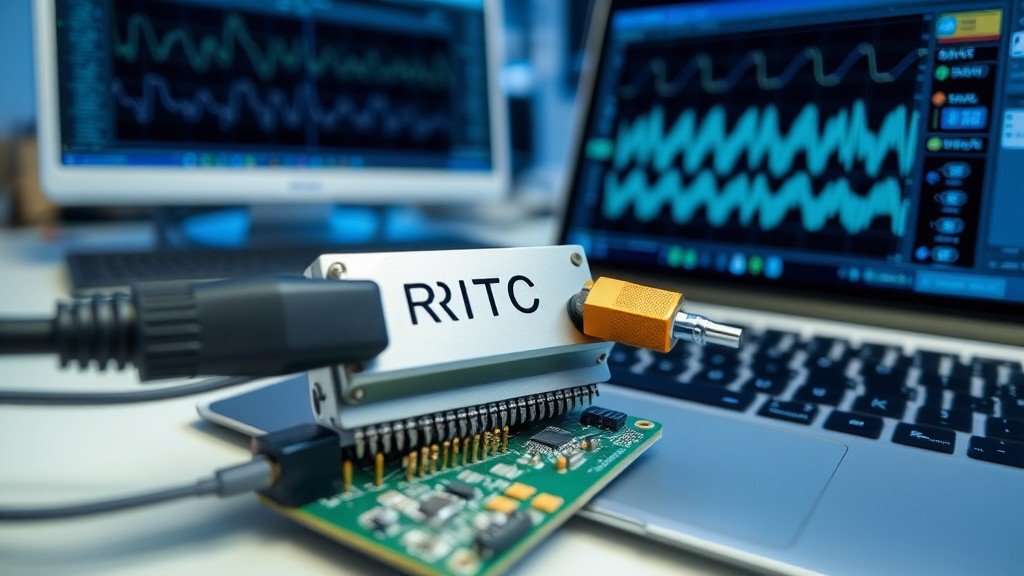Precise timekeeping is vital for computers and embedded systems. Real-time clock (RTC) modules enable accurate time tracking, even during power outages. Diagnosing issues with RTCs requires specialized tools. Logic analyzers capture and display RTC signals to check for errors. Oscilloscopes visualize RTC waveforms to identify abnormalities. (1)
Frequency counters measure RTC crystal oscillations to verify accuracy. RTC integrated circuits can be tested using IC test clips and breakout boards. Software debuggers inspect RTC registers and memory. Choosing the right diagnostic tools is crucial for evaluating real-time clock performance and troubleshooting problems. With the proper equipment, RTC issues can be swiftly identified and resolved.
Key Takeaway
- RTC diagnostics tools help ensure accurate timekeeping.
- Different tools are available, like software, hardware, and calculation tools.
- Using these tools can help fix time-related problems in devices.
Diagnostic Software Tools
Credits : mang lian
Keeping time running smoothly is key for many gadgets. Real-time clock (RTC) chips help computers, hidden systems, and more track time exactly. Even if power cuts out, RTCs keep ticking. Knowing which tools test RTCs is vital. Read on to learn about top RTC testing tools.
Checking Tools
Software tools play a big part in checking how RTC chips work. One helpful tool is the Twilio RTC Checking Tool. This tool is made to test Voice over Internet Protocol (VoIP) links. It assists users in making sure calls sound clear and work well.
The tool has some important features. First, it has Bandwidth Tests. This checks how much web speed is needed for VoIP calls. Users can see if their web link is strong enough for good call quality. If speed is too low, calls may cut out or sound bad.
Next, VoIP Quality Checks look at how clear sound is during talks. If there are issues, users can fix them.
Testing Gadgets checks mics and speakers to ensure they work right. Users can quickly check if they can hear and be heard clearly on calls.
Finally, Report Making creates easy reports to share. They show any problems found during testing. This makes it simple to see issues and fix them.
Using tools like the Twilio RTC Checking Tool helps find time and VoIP problems. By making sure all works well, users can enjoy clear, reliable chats.
Figuring RTC Chips
Figuring tools are very important for checking how well RTC chips work. Epson has some handy tools to help with this. These tools assist engineers and techs in understanding RTC chips better. They can find out how temperature and power affect timekeeping.
One useful tool is Temp vs. Clock. This Excel sheet shows how temp changes can impact clock accuracy. The tool calculates clock errors from temp ups and downs. This matters because RTC chips may be used in different places, and temp can change how well they keep time. Knowing this helps users make tweaks to keep the clock right.
Another good one is Battery Backup Figuring. This helps users see how long a battery can run the RTC if power cuts out. It looks at battery type and stored energy. Knowing this ensures devices don’t lose time during outages.
Lastly, there’s Digital Offset Figuring. This tool adjusts data when engineers use special RTC functions. Sometimes, the data needs fixing to stay accurate. This simplifies that, making it easier to manage RTC data.
Overall, these figuring tools are key for accurate, reliable RTC chips. They provide important info on how factors affect timekeeping, helping engineers make informed choices.(2)
Hardware Checking Tools
Hardware checking tools are crucial for finding problems with RTC chips. These tools help techs and engineers check if the hardware works right. One important tool is the Oscilloscope. This device measures the RTC crystal oscillator frequency. The oscillator keeps time accurately.
Using an oscilloscope, users can see if the frequency is stable and in the right limits. If it’s off, it can cause timekeeping issues. This tool makes sure everything works correctly. Another good one is the Multimeter. This checks the voltage at the RTC chip. It measures the electrical power the chip gets.
Having the right voltage is key for the RTC to work properly. If voltage is too low or high, the chip may not work right. A multimeter ensures the RTC gets the proper power to keep good time. The Logic Analyzer is also helpful. It watches the signals between the RTC and microcontroller. This means it checks communication between the two.
The logic analyzer looks at the data going back and forth. It helps verify the info is correct. Any data errors can lead to timekeeping problems. Using these hardware tools can quickly find RTC chip issues. They give valuable info on how well the hardware works.
By troubleshooting with them, techs can fix problems and keep devices running smoothly. With the right hardware diagnostic tools, real-time clocks can stay precise for many gadgets and systems.
Inside Checking Tools
Many new systems have built-in tools to help check RTC chips. These tools make finding and fixing problems easier right away. Here are two key built-in checking tools:
One tool is Power-On Self-Check (POST). This test runs automatically when the computer starts. It checks if all hardware parts work right, including the RTC chips. If there’s an issue, POST can alert the user with a beep or screen message. This quick check makes sure the system is ready and timekeeping is accurate. Any RTC problems can be addressed before startup finishes.
Another good one is System Controller Checking. Some systems have special controllers that self-test during startup. They check how well the time functions work. They run tests to see if the RTC keeps time accurately. If they find any issues, they can alert the user. This allows quick troubleshooting to fix problems.
These built-in checks make finding and fixing RTC problems much easier when starting up. Using these tests, users can be sure their devices work right and keep good time. This prevents disruptions and keeps everything running smoothly.
Conclusion
In summary, using the right tools for RTC diagnostics is key. Software, math, hardware, and built-in system tools all help ensure RTC chips keep good time. By using these tools, engineers can quickly find issues and maintain reliable timekeeping in all devices. Keeping time right helps everything run smoothly!
FAQ
What is an RTC module, and how does it help in data logging?
An RTC module, like the DS1307 RTC, keeps accurate time even when the system is off, thanks to its battery backup. It’s essential for data logging tasks, like timestamping sensor data, ensuring real time data is recorded precisely.
How does an SD card work with a data logging shield?
A data logging shield uses an SD card or micro SD card, often formatted as FAT16 or FAT32, to store log data like sensor data. It connects through a card reader module and works with Arduino IDE libraries like the SD library.
Why is battery backup crucial for RTC modules?
Battery backup, often with a coin cell or lithium battery, prevents damage to the RTC chip and keeps the real time clock module running during power loss, ensuring accurate time is maintained for tasks like temperature logging.
How do you connect an SD card reader to Arduino Uno?
Use a shield for Arduino, such as a data logger shield or an SD shield, to integrate an SD card reader. Header pins and level shifter circuitry help connect the reader securely to digital pins for smooth data logging operations.
What tools are needed to log temperature sensor data with Arduino?
To log temperature data, you need tools like a DS18B20 sensor, a data logging shield with an RTC module, and a microSD card. Use Arduino IDE, the SD library, and an RTC library to record data in a CSV file and view it with a serial monitor.
How does RTC data logging work with Arduino?
RTC data logging combines an RTC chip, such as the DS1307 RTC, with a data logger shield to timestamp real time clock data. You can log serial data to a microsd card in CSV format for later analysis.
What is the role of push buttons in Arduino data logging shields?
Push buttons allow you to interact with data logging shields for functions like setting the time on the RTC module. They work with Arduino libraries and digital pins to adjust configurations or trigger specific actions.
How does a logger shield prevent damage to SD cards?
Logger shields use features like level shifter circuitry to ensure proper voltage levels, which prevents damage to SD cards or micro SD cards during data logging operations.
How do I view log data stored on an SD card?
Log data on an SD card can be accessed using a card reader module and viewed on a computer. Files like CSV or ZIP are commonly used, and you can also analyze data through a serial monitor in the Arduino IDE.
Can I use an Arduino Uno for real time clock data logging?
Yes, Arduino Uno is ideal for RTC data logging. Pair it with an RTC data logging shield, a real time clock module like the DS1307, and an SD card. Use Arduino IDE libraries to record and analyze sensor data with accurate timestamps.
References
- https://docs.byteplus.com/id/docs/byteplus-rtc/docs-125643
- https://data.safetycli.com/packages/pypi/rtc-tools-diagnostics/?utm_source=pyupio&utm_medium=redirect&utm_campaign=pyup_rd&utm_id=0817&utm_content=data


